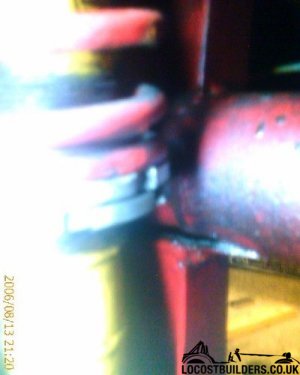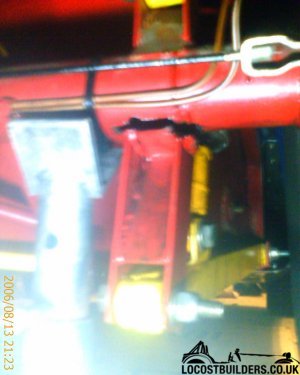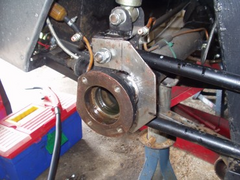
Scary stuff
watsonpj - 13/8/06 at 11:36 PM
Went out in the car last weekend and noticed that the axle was starting to whine, so thought it was time for a new diff  but not too bad so can
wait till winter.
but not too bad so can
wait till winter.
Then had a friend come over from the US on thursday so took him for a drive, but said I'd take it easy because of axle. Wasn't long before
the noise from the axle was really getting bad so headed for home, I'm think just a new diff and all will be well ............
Tonight jacked the car up and I noticed there was a lot of oil around the shock on the passenger side and then this 




[img]http:// [/img]
[/img]
notice the crack where the suspension bracket is welded to the axle. So I now know why the diffs gone theres no oil in it.
So I checked around the back of the axle on the same side
and 


[img]http:// [/img]
[/img]
so I thought i'd check the drivers side and this is the really 






 one
one
[img]http:// [/img]
[/img]
I feel lucky to get home at all. I'm going to post a link to this in the sylva site (google group ) see if anyone else has seen anything like
it.
In the mean time is anyone has an escort axle they want to offload I guess I'm in the market 
SixedUp - 14/8/06 at 12:35 AM
Scarey. Just glad you found out what was happening before it failed catastrophically.
Cheers
Richard
[Edited on 14/8/06 by SixedUp]
gregf27 - 14/8/06 at 07:49 AM
How lucky were you!!
In the pic , it looks like the shocks are mounted directly to the lower trailing arm??
If so the shocks would have been constantly excerting their downward /upward forces directly into the trailing arm, and after time has caused the
area around the axle bracket to fail either by metal fatique or a stress fracture,
When you get another axle, I would first check with your kit manufacturer to check whether they have carried out any improvements/strengthening mods
,
If you cant reposition the shocks to fit on top of the axle, then I would make 2 trailing arm brackets that completely encircles the circumference of
the axle and seam weld it all round ,
Main thing is - no-one was injured!!
let me know how you get on!!
regards,
Greg
procomp - 14/8/06 at 07:58 AM
Hi it is a well nown problem for the brackets on the rear trailing arm to fail first at the chassis it seems like yours have gone at the axle end so i
would check all of the chassis brackets as well . And also check the bushing as the sylva's have to run a compliant bush setup as the geometry is
working against it's self if the bushes are to hard it dosent take long for your situation to happen . Just be glad that the rear chassis bracket
did'nt depart company as you end up with the propshaft breaking at the rear uj and that is scary.
cheers matt
Peteff - 14/8/06 at 09:12 AM
Are the axle brackets welded on in two separate pieces, top and bottom, with nothing joining them at the back?. They should be like the locost bracket
That's a disaster waiting to happen if the axle casing is taking the brunt instead of the bracket taking it and supporting the axle. They need
bracing together at the rear with a web or make them out of an open fronted box with a half circle cutout for the axle to fit in.
Fred W B - 14/8/06 at 11:02 AM
I would call the detail as photographed PPD....
Pi.. Poor Design
Cheers
Fred WB
[Edited on 14/8/06 by Fred W B]
Surrey Dave - 14/8/06 at 11:09 AM
I also fitted my own 'southern jessie plates'


Rescued attachment plate front bolted sml.jpg
Liam - 14/8/06 at 11:37 AM
Crikey!!!
As mentioned above the problem is certainly because the shock mounts on the bottom trailing arm. All the suspension loads are constantly trying to
rip the bottom bracket off the axle (and have succeeded)!! Really crap design - the trailing arms should be for location only. If you're gonna
mount a shock on one the design of the bracketry should have been up to the job!!
Liam
NS Dev - 14/8/06 at 12:13 PM
not wishing to start a debate but I don't think the shocker load has caused this one.
Read Procomp's reply, I think this is the real reason.
The sylva uses longitudinal watts linkages in place of a 4 trailing link setup. You only need to be a fraction out on link lengths or have a bent
bracket or one welded on a bit askew, and in bump and droop the whole axle becomes a torsion link, and the forces can be totally out of proportion to
what you would expect due to the angles involved.
As Procomp said, stiffer than normal bushes plus some geometry slightly adrift could soon crack it through torsional fatigue.
Liam - 14/8/06 at 12:25 PM
Aah I wasn't aware the Sylva didn't just use a rear setup like a locost. Looks like it does in the pics. Fair enough. Still the shock
mounting position is hardly gonna help - if torsion was the only problem wouldn't you expect the top brackets to be in just as bad shape?
Liam
MikeRJ - 14/8/06 at 12:33 PM
I have to agree, I can't see the location of the shock having much, if anything, to do with this failure.
leto - 14/8/06 at 04:19 PM
The lower bracket usually takes higher loads from braking and should be the one to go first on a four link. The shock mount probably helped to make
the lower bracket brake first. What caused the failure is harder to tell, the combined load was clearly to high.
With stiff bushes there will be the same kind of problems on a standard four link.
watsonpj - 14/8/06 at 04:51 PM
Thanks for all the posts guys.
I've now had some replies on the google group and it confirms that it is a problem that has been seen many times before. I have also spoken to
fisher and the bracket has been changed so that the upper and lower are linked so spreading the load over a larger area of the axle. New improved
casing is £200 and then I need a diff so I guess I'm in for about £300 so not terrible.
I think that the spring/shock position will have a contribution as the weight of that corner of the car is hanging off of the weld. I do think however
that its the probably the torsional effect of accel/decel that actually killed it. This is coupled with a a relatively small area of contact between
axle and bracket, and probably some embrittlement around the weld area.
Cheers again pete
JB - 14/8/06 at 06:33 PM
As the axle moves up in bump then the axle must rotate.
The top link which goes backwards will pull the top of the axle backwards.
The bottom link that goes forward will pull the bottom of the axle forwards.
This seems fine in 2 wheel bump or droop but it seems the axle is one dirty great roll bar. So in roll the axle will want to twist.
Now theres nothing wrong with this but the design of brackets etc should be up to it. This is a classic example of not understanding loads and how
they will react.
Would a floating / rotating mount at one side remove all the twisting load but still allow axle location?
John
MikeRJ - 14/8/06 at 07:49 PM
quote:
Originally posted by JB
Would a floating / rotating mount at one side remove all the twisting load but still allow axle location?
John
I was thinking the same, but then all axle torque reactions would then be directed through one bracket, so I reckon the failure mechanism could still
be present, albeit from a different cause.
Possibly make both floating and add another central link to handle axle torque reactions? I believe that this is what some US live axled competition
cars do.
Given the fragility of the English axle w.r.t. the very thin axle tubes, this suspension arrangment doesn't seem like a very clever idea, but you
can't argue with the Strikers success on the track.
NS Dev - 15/8/06 at 12:21 PM
Hit the nail on the head there.
If you look at the common 70's and 80's racing english axle setups, one that is very common is the 3 link (plus transverse panhard or watts
linkage)
I think it was used by Jeff Beddings?? on lots of circuit and oval cars.
The reaction linkwas mounted off the top of the diff.
Doesn't help here though as there's nowt on the car to mount off, so go for the better brackets and use rubber bushings at least at one end
of the links.
 but not too bad so can
wait till winter.
but not too bad so can
wait till winter. 




 [/img]
[/img] 


 [/img]
[/img] 






 one
one  [/img]
[/img] 


